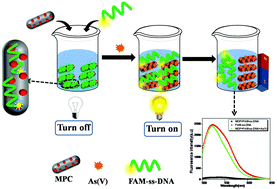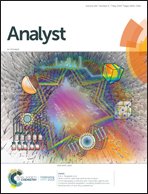Immobilization of ssDNA on a metal–organic framework derived magnetic porous carbon (MPC) composite as a fluorescent sensing platform for the detection of arsenate ions†
Abstract
In this work, we fabricated a metal–organic framework derived magnetic porous carbon (MPC) composite using a one-pot solid state template method. The formation of the synthesized composite was confirmed with various spectroscopic techniques, and it was proved that the composite can effectively quench the fluorescence of ssDNA. This property was utilized in the specific and efficient recognition of harmful arsenate ions. FAM-labelled single strand DNA (FAM-ssDNA) was adsorbed on the surface of the MPC composite and immobilized via π–π stacking interactions, which resulted in the fluorescence emission being quenched. A fluorescence quenching efficiency of 96% was achieved, due to the huge surface area of the MPC composite. Upon the addition of As(V) ions into our sensing system, the fluorescence emission dramatically increased, due to the strong affinity for As(V) of the surface of the MPC composite. Consequently, the adsorbed FAM-ssDNA was spontaneously displaced from the surface of the MPC composite, and so the fluorescence intensity was regained. Based on this mechanism, the fabricated biosensor exhibited a highly sensitive fluorescence response to As(V) in the range from 0 to 15 nM, with a detection limit as low as 630 pM. Furthermore, the sensing system is suitable for diverse biological and environmental samples.



 Please wait while we load your content...
Please wait while we load your content...